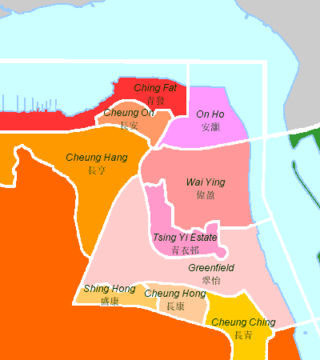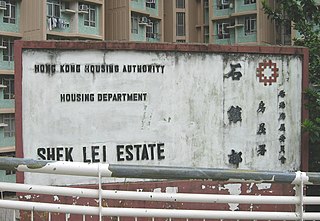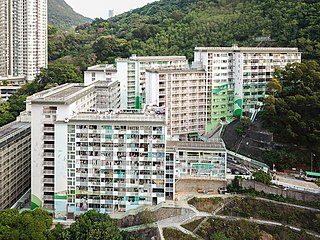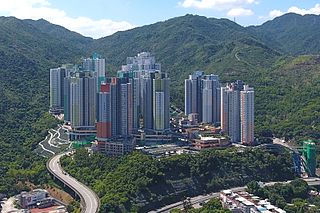
San Po Kong is an area in New Kowloon in Hong Kong. It is largely industrial and partly residential. Administratively, it belongs to Wong Tai Sin District.

The Hong Kong Housing Authority (HA) is the main provider of public housing in Hong Kong. It was established in April 1973 under the Housing Ordinance and is an agency of the Government of Hong Kong. In the same year, the Resettlement Department and the Building Section of the Urban Services Department were merged to form the Housing Department, which acts as the Housing Authority's executive body.

The following is an overview of public housing estates on Tsing Yi, Hong Kong including Home Ownership Scheme (HOS), Private Sector Participation Scheme (PSPS), Flat-for-Sale Scheme (FFSS), Tenant Purchase Scheme (TPS) and Subsidised Sale Flats Project (SSFP) estates.

The 2008 Chinese milk scandal was a significant food safety incident in China. The scandal involved Sanlu Group's milk and infant formula along with other food materials and components being adulterated with the chemical melamine, which resulted in kidney stones and other kidney damage in infants. The chemical was used to increase the nitrogen content of diluted milk, giving it the appearance of higher protein content in order to pass quality control testing. 300,000 affected children were identified, among which 54,000 were hospitalized, according to the latest report in January 2009. The deaths of six babies were officially concluded to be related to the contaminated milk.

Shek Lei Estate, also known by Shek Lei is a public housing estate in Hong Kong, situated in the Shek Lei Pui (石梨貝/石梨背/石犁背) area in northeast Kwai Chung, New Territories, near Shek Yam Estate, On Yam Estate and Shek Yam East Estate.

Yat Tung Estate is a public housing estate in the western part of Tung Chung, Lantau Island, Hong Kong. It is divided into Yat Tung (I) Estate and Yat Tung (II) Estate, which collectively have a population of 36,913.

Sai Wan Estate is a public housing estate in Kennedy Town, Sai Wan, Hong Kong. Built in 1958 and 1959, it sits in a hillside that had to be extensively cut away for its construction. the estate comprises 640 flats in five linear blocks of 10 to 14 storeys. It is the only public housing estate in Central and Western District developed by the Hong Kong Housing Authority and it is the second oldest existing public housing estate built by the Hong Kong Housing Authority, after Model Housing Estate.

Chuk Yuen Estate is a public housing estate in Kowloon, Hong Kong, located north of Wong Tai Sin and underneath Lion Rock. Its site was formerly the Chuk Yuen Resettlement Area.
The following shows the public housing estates in Ngau Tau Kok, Jordan Valley, Kowloon Bay and surrounding neighbourhoods, in Kwun Tong District, Kowloon, Hong Kong.

The following is a list of public housing estates in Wong Tai Sin, Kowloon, Hong Kong including Home Ownership Scheme (HOS), Private Sector Participation Scheme (PSPS), Sandwich Class Housing Scheme (SCHS), Flat-for-Sale Scheme (FFSS), and Tenants Purchase Scheme (TPS) estates.
The following shows the Resettlement Housing estates in Tsz Wan Shan, Wong Tai Sin District, Kowloon, Hong Kong.

Tsz Ching Estate is a public housing estate located in Tsz Wan Shan, Kowloon, Hong Kong next to Tsz Oi Court. It consists of eleven residential blocks completed between 1993 and 2001. The site was formerly Blocks 48 to 53 in Tsz Wan Shan Estate, which was also called "Tsz Ching Estate". After redevelopment, the eastern part of Old Tsz Oi Estate was assigned to Tsz Ching Estate.

Tai Hom Village was the largest squatter village in Kowloon, Hong Kong. Its demolition was completed in 2001, with a few structures of historical value being preserved. The name is still used to designate its former site in Wong Tai Sin District, which is awaiting redevelopment.

The administration of Leung Chun-ying as Chief Executive of Hong Kong, officially referred to as "The 4th term Chief Executive of Hong Kong" relates to the period of governance of Hong Kong since the transfer of sovereignty of Hong Kong, between 1 July 2012 and 30 June 2017.

Helena Wong Pik-wan is a former member of the Legislative Council of Hong Kong for Kowloon West constituency. She is also an academic staff member at Hong Kong Polytechnic University.

The following is an overview of public housing estates in the Kai Tak development area, Kowloon City District, Hong Kong, including Home Ownership Scheme (HOS), Private Sector Participation Scheme (PSPS), and Tenants Purchase Scheme (TPS) estates.

Kai Ching Estate is a public housing estate in a brownfield development area in Hong Kong of the disused Kai Tak Airport. It consists of six residential buildings completed in 2013. It houses around 5,200 flats for 13,300 residents and shares the "Ching Long Shopping Centre" with Tak Long Estate. Kai Ching Estate was built by China State Construction Engineering.

Shui Chuen O Estate is the largest public housing estate in Sha Tin, New Territories, Hong Kong.

The 2015 Hong Kong District Council elections were held on 22 November 2015. Elections were held to all 18 District Councils with returning 431 members from directly elected constituencies after all appointed seats had been abolished.

King Tai Court is the first Green Form Subsidised Home Ownership Scheme court developed by the Hong Kong Housing Authority and located at King Fuk Street, San Po Kong of Wong Tai Sin District, Kowloon, Hong Kong. It commenced in June 2017.




















